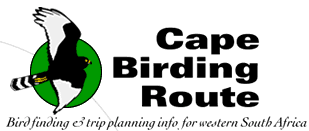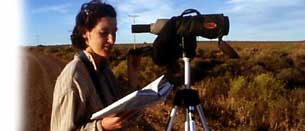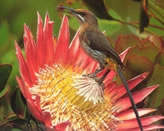| Kalahari
Gemsbok National Park: Twee Rivieren and Beyond
At Twee Rivieren, have a look around the
stand of thorn-trees to your right as you enter the main park
gate for typical thornveld birds such as Crimson-breasted
Shrike, Scimitarbilled Woodhoopoe, Swallow-tailed
Bee-eater, Kalahari Robin, Marico Flycatcher,
White-browed Sparrow-weaver and Ashy Tit. This
is a good place to practise the productive birding technique
of whistling the piercing call of Pearl-spotted Owl
to attract mobbing bush-birds — you may well find yourself
calling up an owl in the process, even during the middle of
the day. In fact, all three of the Kalahari rest camps are
excellent for owls, and a night walk to follow up on calls
in any of the three is likely also to turn up White-faced,
Scops, Spotted Eagle and Barn Owls. Ask
the staff for their daytime whereabouts. Pygmy Falcon
regularly hunts inside Twee Rivieren camp, and is in fact
fairly common throughout the park.
We
recommend spending the first night at Twee Rivieren, in
order to make an early morning start northwards into
the park. Shortly after leaving the rest camp, take the first
turn-off to Mata Mata, and in the first 3 km of dunes look
for Pink-billed and Clapper
Larks (p.116*) and, if there have been good rains,
Kurrichane Buttonquail. Fawn-coloured Lark is
the park’s most common lark and is also likely to be
seen here, as is Desert Cisticola. Return now to the
main Nossob road, and continue northwards past the junction
of the Nossob and Auob riverbeds, aiming to reach the waterholes
of Leeudril, Rooiputs and Kijkij 2—4 hours after sunrise.
This will maximize your chances of seeing the scarce Burchell’s
Sandgrouse (p.116*), alongside the much more abundant
Namaqua Sandgrouse. In wet years, listen for the incessant
calls of Monotonous Lark along the river valleys.
All
of the park’s waterholes are invariably lined with flocks
of drinking seedeaters making nervous forays to the water’s
edge, especially in winter. The most common of these are Scaly-feathered
and Red-headed Finches, Sociable Weaver and
Lark-like Bunting. During the summer months, huge flocks
of European Swift are in evidence overhead, and Lesser
Grey Shrike is commonly seen from the roadside. Great
Spotted Cuckoo is also present at this time.
Continue
towards Nossob rest camp. Dikbaardskolk picnic site, which
makes a good lunch spot, is frequented by Ground Squirrels
(Geosciuris inauris) and a selection of skinks and
agamas. Look for the uncommon Great Sparrow in the
larger trees here and in Nossob rest camp. As you approach
the camp, particularly northwards of Kaspersdraai, several
additional species start becoming more evident: waterholes
begin to attract Violet-eared Waxbill and its brood
parasite, Shaft-tailed Whydah. Red-necked Falcon
also starts to become much more common than further south
in the park — look out for hunting birds targeting the
flocks of drinking seedeaters; the falcons also regularly
hunt over the Nossob rest camp.
If
you are spending two nights at Nossob rest camp, it is possible
to make the full day’s excursion to the park’s northern
fingertip at Union’s End. As you head north from Nossob
and towards Union’s End (look for Burchell’s
Sandgrouse at Cubitje Quap waterhole), bushveld elements
such as Lilac-breasted Roller, Yellow-billed Hornbill,
Golden-tailed Woodpecker and Temminck’s Courser
become more evident. The Union’s End waterhole at the
lonely junction of three national states — South Africa,
Namibia and Botswana — is notable for occasionally hosting
drinking flocks of Rosy-faced Lovebird. Nossob rest
camp itself offers similar birding to Twee Rivieren. Ask the
staff to show you the daytime roost of the resident White-faced
Owls.
Two
roads cut across the central dunefield between the two riverbeds.
There is little game along these routes, but they are well
worth the drive not only for the landscape and short-cut to
the Auob, but also for Pink-billed Lark. This species
is difficult to find in much of the Northern Cape and undergoes
local movements. Look out for foraging birds around the bases
of grass clumps, and do not be put off by their apparently
white (not buff) outer tail feathers. Despite this incongruence
with the field guides, they are indeed Pink-billed
and not Botha’s Larks (the latter has a localized
distribution in eastern South Africa). Northern Black Korhaan,
Anteating Chat and Grey-backed Finchlark are
also particularly common along these roads.
Having
reached the broad and shallow Auob riverbed near Kamqua waterhole,
you have the option of either making a detour to Mata Mata
rest camp on the Namibian border, or completing your loop
through the park by returning to Twee Rivieren. The Auob riverbed
is superb Cheetah country — enquire locally about game
viewing. It is also an excellent place to see Giant
Eagle Owl (p.116*); check the huge and gnarled camelthorn
trees that line the riverbed.
|


